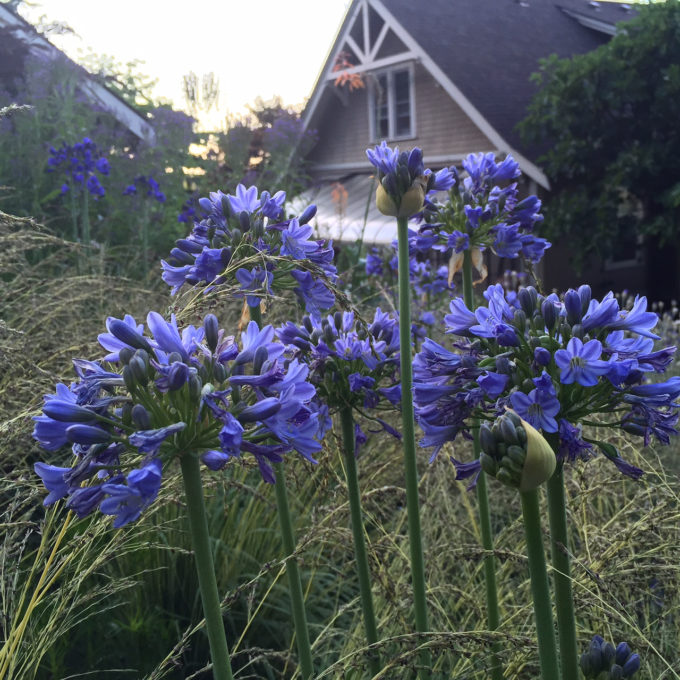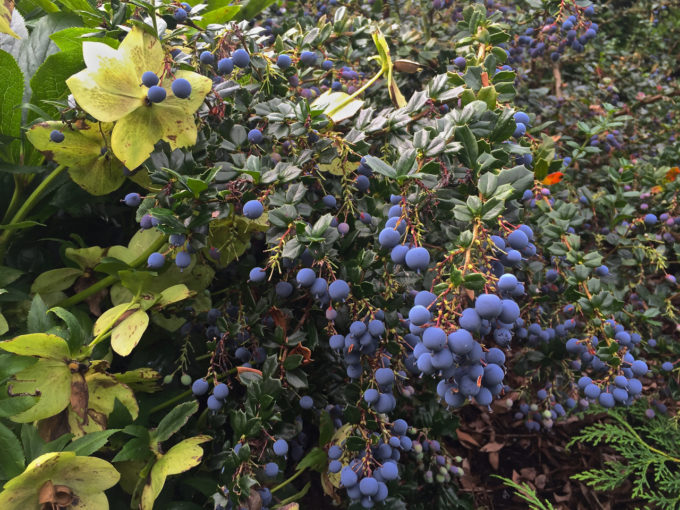Summer is my favorite time in the garden. Long, warm days to kick back and enjoy a bounty of flowers and foliage in a rainbow of color.
Blue is the #1 favorite color of all people. It is nature’s color for water and sky, embraced as the hue of heaven and authority, and worn universally in denim clothing. In my garden, Agapanthus ‘Joyful Blue’ is beginning to bloom…shooting up through a sea of Molinia caerulea ‘Variegata’.

Gardeners have a fascination with “true” blue flowers in the garden. We are enticed by photos of Himalayan blue poppies (Meconospis spp.) and promises of an endless summer of blue mophead hydrangeas or a lacecap like Hydrangea serrata ‘Bluebird’.
In our warm, dry, intensely bright Pacific Northwest summers, blue flowers, fruits, and foliage offer calming relief. For backdrop in my own garden, we’ve planted a few leafy blue evergreen trees, notably Cunninghamia lanceolata ‘Glauca’ with its fat, wide frosty blue needles and Eucalyptus pauciflora subsp. debuzevillei, a large-leaved version of the snow gum with chalky blue leaves that contrast nicely with its earth-toned copper-pink-green-white patchwork bark.
For blue summer fruit, nothing beats edible blueberries, either lowbush (Vaccinium angustifolium) or highbush (Vaccinium corymbosum). I am still amazed at the mind-blowing blueberry selections available to HPSO gardeners in Portland regional nurseries. Aside from the juicy summer fruit, multi-stemmed blueberries offer deciduous leaves that turn bright yellow, orange, and vibrant shades of red in autumn.
Oregon-grape (Mahonia (synonym:Berberis) aquifolium) is our state flower – yellow spring blooms that yield clusters of round, dusky blue summer fruit. The tart, edible berries don’t offer the same sweetness of fresh-picked blueberries, but who cares! Mahonia is a dynamic shrub with 4-season interest, particularly hybrid varieties like M. x media ‘Arthur Menzies’, ‘Charity’, ‘Lionel Fortescue’ and ‘Winter Sun’. No garden should be without one…or two!
Another favorite blue-fruiting shrub in our garden is Berberis darwinii. Remarkable clusters of intense blue fruit ripen in summer…and freshen up fading hellebore flowers.

I delight in all forms of California lilac (Ceanothus) and their adaptability to our dry summers. Perhaps my new favorite is Ceanothus x ‘Topaz’, a great summer-bloomer with some of the darkest, deep blue-black flowers in the genus. Flower trusses on ‘Topaz’ are loose and airy, lending informality in the summer garden.
Among blue-flowering perennials, several really sing in summer. Penstemon heterophyllus ‘Electric Blue’ leads the parade. Its zappy true blue flowers smother the foliage for up to six weeks in late spring and then sporadically through summer with some deadheading.
Lithodora diffusa ‘Grace Ward’ may seem a rather common box store perennial, but its flowers are among the most intense deep blue. It is a wonderful groundcover or rock garden accent with sprawling to slightly mounded form.
On our northwest Portland hillside, two blue-flowered perennials dominate the summer scene. Catananche caerulea (Cupid’s dart) grows in clumps of narrow gray-green foliage with wiry flower stems of cornflower blue to violet-lavender fringed daisies. Catananche is a dynamic bedfellow with Molinia caerulea ‘Variegata’ on one of our terraces.
My other newly favored perennial is Agapanthus with strappy green foliage down on the ground and aerial globes of powder blue, royal, and blue-black that drift across our summer plantings. Standouts are Agapanthus ‘Joyful Blue’ with soft blue flower heads fading to a milky lavender (a Joy Creek Nursery selection) and A. ‘Blue Leap’, a vigorous, hardy variety chosen for its ability to “leap” across our hillside. We purchased ‘Blue Leap’ from Dan Hinkley at Windcliff Plants. Dan originally selected and introduced ‘Blue Leap’ through Heronswood Nursery.
I use grasses and sedges liberally in my garden designs to knit plantings together at the ground plane. Many are blue-bladed like little bluestem (Schizachryrium scoparium ‘The Blues’), blue oat grass (Helictotrichon sempervirens ‘Sapphire’), blue fescue (Festuca ovina ‘Elijah Blue’) and blue sedge (Carex flacca ‘Blue Zinger’). I’m discovering the merits and best use of native Festuca californica and the South American blue wheat grass (Agropyron magellanica) which froms a striking evergreen clump of intense blue foliage. A couple of blue-foliaged perennials like Euphorbia rigida, Parahebe perfoliata (Digger’s speedwell), and Agastache ‘Blue Boa’ work wonderfully spiking up through some of these blue grasses and sedges. Blue foliage, flowers, and fruits offer cool summer moments, and at the same time make your garden ZING.